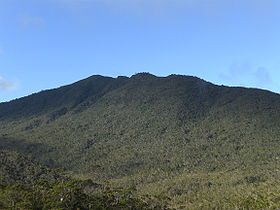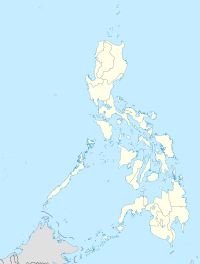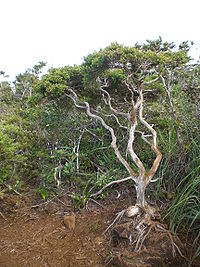- Mount Hamiguitan
-
Mount Hamiguitan
Mount HamiguitanElevation 1,620 m (5,315 ft) Prominence 1,497 m (4,911 ft) [1] Pronunciation [hamiɡuitan] Location Location of Mount Hamiguitan in the Philippines Location  Davao Oriental, Philippines
Davao Oriental, PhilippinesRange Hamiguitan Mountain Range Coordinates 6°44′24″N 126°10′54″E / 6.74°N 126.18167°ECoordinates: 6°44′24″N 126°10′54″E / 6.74°N 126.18167°E[1] Geology Type Stratovolcano Mount Hamiguitan is a mountain located in the province of Davao Oriental. It has a height of 1,620 meters (5, 314.96 ft.). The mountain and its vicinity has one of the most diverse wildlife populations in the Philippines. Among the wildlife found in the area are Philippine eagles and several species of Nepenthes. Some of the latter, such as the Nepenthes peltata, are endemic to the area.[2] The mountain has the only protected forest in the Philippines, with an estimated area of 2,000 hectares. This forest is noted for its unique pygmy forest of century old trees in an ultramafic soil, with many endangered, endemic and rare species of flora and fauna.[3][4]
The Mount Hamiguitan Range, with an area of 6,834 hectares (68.34 km2), was declared a national park and Wildlife Sanctuary in 2003.[5] In 2009, the provincial officials of Davao Oriental submitted the park for listing as a UNESCO World Heritage Site.[4]
Contents
Location and geography
Mount Hamiguitan is located in the province of Davao Oriental in the southeastern part of the island of Mindanao, Philippines. It occupies the land area within the political boundaries of Mati, San Isidro and Governor Generoso.[5]
Flora & Fauna
Plants
Inventory of flora species in the mountain and its vicinity showed that its montane forest has the highest species richness of plants with 462 species, followed by its dipterocarp forest with 338 species, mossy forest with 246 species and agro-system with 246 species. Some of the plants commonly found on Mount Hamiguitan include the following:[4]
- Leptospermum flavescens
- Wendlandia nervosa
- Tristaniopsis micrantha
- Dacrydium elatum
- Calophyllum blancoi
- Symplocos polyandra
- Almaciga (Agathis philippinensis)
- Elaeocarpus verticillatus
- Patersonia lowii
- Astronia lagunensis
- Nepenthes alata[6]
- Nepenthes hamiguitanensis[7]
- Nepenthes micramphora[6]
- Nepenthes mindanaoensis[6]
- Nepenthes peltata[6]
- Schizaea inopinata
- Schizaea malaccana
- Paphiopedilum ciliolare
- Dipodium paludosum
- Epigeneium sp.
- Dendrochilum longilabre
- Dendrochilum tenellum
- Dendrochilum sp. (Unknown species)
- Macodes petola
- Coelogyne chloroptera
- Bulbophyllum sp.
- Appendicula sp.
- Gleichennia hirta
- Drimys piperita
- Hydnophyton sp.
Animals
The International Union for Conservation of Nature (IUCN) Red List has identified at least 11 endangered vertebrate species. The Philippine Council for Agriculture, Forestry and Natural Resources and Development (PCARRD) reported that the mountain is inhabited by five endangered species, 27 rare species, 44 endemic species and 59 economically important species. The following species can be found in the area:[4]
- Philippine eagle (Pithecophaga jefferyi)
- Giant Golden-crowned Flying Fox (Acerodon jubatus)
- Philippine Forest Roundleaf Bat (Hipposideros obscurus)
- Philippine Tarsier (Tarsius syrichta)
- Philippine Warty Pig (Sus philippinensis)
- Philippine Brown Deer (Cervus mariannus)
- Fischer's Pygmy Fruit Bat (Haplonycteris fischeri)
- Asian Palm Civet (Paradoxurus hermaphroditus)
- Tawitawi Brown-dove (Phapitreron cinereiceps)
- Tarictic Hornbill (Pinelopides panini)
- Grey-hooded Sunbird (Aethopyga primigenius)
- Giant Scops-owl or Mindanao Eagle-owl (Mimizuku gurneyi)
- Batomys hamiguitan (a yellow-brown furry-tailed rat species endemic to the area)
References
- ^ a b de Ferranti, Jonathan; Aaron Maizlish. "Philippine Mountains - 29 Mountain Summits with Prominence of 1,500 meters or greater". http://www.peaklist.org/WWlists/ultras/philippines.html. Retrieved 2009-01-09.
- ^ "Nepenthes species in the Philippines". The International Carnivorous Plant Society. 2008-04. http://www.sarracenia.com/faq/faq5412.html. Retrieved 2009-01-09.
- ^ "Davao Oriental wants Hamiguitan declared as world heritage site". GMA 7. 2008-05-05. http://www.gmanews.tv/story/93472/Davao-Oriental-wants-Hamiguitan-declared-as-world-heritage-site. Retrieved 2009-01-09.
- ^ a b c d "Mount Hamiguitan Range Wildlife Sanctuary". UNESCO. http://whc.unesco.org/en/tentativelists/5487/. Retrieved 2011-01-31.
- ^ a b "An Act Declaring Mount Hamiguitan Range And Its Vicinities As Vicinities As Protected Area Under The Category of Wildlife Sanctuary And Its Periphral Areas As Buffer Zone and Appropriating Funds Therefor". Congress of the Republic of The Philippines. 2003-07-23. http://www.lawphil.net/statutes/repacts/ra2004/ra_9303_2004.html. Retrieved 2009-01-09.
- ^ a b c d McPherson, S.R. 2009. Pitcher Plants of the Old World. 2 volumes. Redfern Natural History Productions, Poole.
- ^ Gronemeyer, T., A. Wistuba, V. Heinrich, S. McPherson, F. Mey & A. Amoroso 2010. Nepenthes hamiguitanensis (Nepenthaceae), a new pitcher plant species from Mindanao Island, Philippines. In: S.R. McPherson Carnivorous Plants and their Habitats. Redfern Natural History Productions Ltd., Poole. pp. 1296–1305.
- Amoroso, V.B. & R.A. Aspiras 2011. Hamiguitan Range: a sanctuary for native flora. Saudi Journal of Biological Sciences 18(1): 7–15. doi:10.1016/j.sjbs.2010.07.003
World Heritage Sites in the Philippines World Heritage Sites Baroque Churches of the Philippines (San Agustin Church · Paoay Church · Santa Maria Church · Miag-ao Church) · Puerto Princesa Subterranean River National Park · Rice Terraces of the Philippine Cordilleras ( Batad Rice Terraces · Bangaan Rice Terraces · Hungduan Rice Terraces · Mayoyao Central Rice Terraces · Nagacadan Rice Terraces) · Tubbataha Reef · Historic Town of Vigan
Tentative List Agusan Marsh Wildlife Sanctuary · Angono Triglyphs · Apo Reef Natural Park · Baroque Churches of the Philippines Extension (Boljoon Church · Guiuan Church · Loboc Church · Lazi Church · Tumauini Church) · Batanes Protected Landscapes and Seascapes · Butuan Archeological Sites · Chocolate Hills Natural Monument · Coron Island Natural Biotic Area · El Nido-Taytay Managed Resource Protected Area · Jesuit Churches of the Philippines (Guiuan Church · Baclayon Church · Loboc Church ) · Kabayan Mummy Burial Caves · Ligwasan Marsh · Mount Apo Natural Park · Mount Hamiguitan Range Wildlife Sanctuary · Mount Iglit-Baco National Park · Mount Malindang Range Natural Park · Mount Matutum Protected Landscape · Mount Pulag National Park · Neolithic Shell Midden Sites in Lal-lo and Gattaran Municipalities · Northern Sierra Madre Natural Park and outlying areas inclusive of the buffer zone · Paleolithic Archaeological Sites in Cagayan Valley · Panglao Island, Bohol · Petroglyphs and Petrographs of the Philippines · San Sebastian Church · Spanish Colonial Fortifications of the Philippines (Fuerza de Capul · Dauis Watchtower · Punta Cruz Fortification · Fuerza de San Andres · Fuerza de Sta. Isabel) · Taal Volcano Protected Landscape, Batangas · The Maranao Settlement of Tugaya · The Tabon Cave Complex and all of Lipuun · Turtle Islands Wildlife SanctuaryPrevious Nomination Historic Centre of Manila Intramuros · Town of TaalCategories:- Mountains of the Philippines
- Association of Southeast Asian Nations heritage parks
Wikimedia Foundation. 2010.




